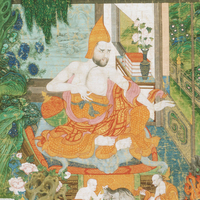
Bhavaviveka
Bhavaviveka (Legs-ldan ‘byed, Skt. Bhāvaviveka), also known as Bhaviveka and Bhavya, is thought to have been born in southern India around 500 CE. Little is known about Bhavaviveka's early life, including his exact birthplace and the circumstances leading to his monastic ordination. What is clear, however, is that from an early age, he was deeply engaged with Buddhist teachings, showing a keen intellect and a propensity for critical analysis. His early education may have included study of epistemology and logic under the Buddhist Sautrantika master Dignaga, who was one of the most important Buddhist logicians of the time. Equipped with the tools of traditional Indian logic, he travelled around India studying and debating with masters from all the Buddhist and non-Buddhist traditions of his time, laying the groundwork for his later philosophical contributions.
His method of debate was in direct contrast with the “prasanga” method that Nagarjuna and his commentator Buddhapalita had employed, which debated by merely pointing out the absurd consequences that followed from their opponents’ assertions. Many centuries later, Tibetan masters attributed the founding of the Svatantrika interpretation of Madhyamaka to Bhavaviveka’s works, especially his Lamp for Discriminating Awareness: A Commentary on (Nagarjuna’s) “Root (Verses) for the Middle Way” (dBu-ma rtsa-ba’i ’grel-pa shes-rab sgron-ma, Skt. Prajñapradīpa Mūlamadhyamaka-vṛtti) and its main Indian commentary, Extensive Subcommentary to (Bhavaviveka’s) “Lamp for Discriminating Awareness,” (Shes-rab sgron-ma rgya-cher ‘grel-pa, Skt. Prajñāpradīpam-ṭīkā), written in the 8th century by Avalokitavrata (sPyan-ras-gzigs brtul-zhugs, Skt. Avalokitavrata).
The Tibetan masters asserted that Bhavaviveka’s use of traditional syllogistic logic is the distinctive feature differentiating his interpretation of Nagarjuna’s work from Buddhapalita’s use of prasanga reasoning. Further, in Bhavaviveka’s affirmation of external phenomena in his critique of the Chittamatra (Mind-Only) tenets, the Gelug tradition attributes the founding of what it calls the “Sautrantika Svatantrika” school of Madhyamaka to him.
The main point of Bhavaviveka’s critique of the prasanga method was that to engage opponents in debate it was necessary to refute their assertions with an implicative negation that leaves in its wake affirmation of the topic of debate. Otherwise, refuting the topic with a nonimplicative negation leaves no common ground for analysis. Based on this and also on Bhavaviveka’s assertion that the defining characteristic of the self is found in mind consciousness as the basis for imputation, the Gelug tradition asserts that Bhavaviveka merely refutes unimputed existence but accepts self-established (inherent) existence. Gelug then asserts that the Prasangika interpretation of Madhyamaka, as formulated by Chandrakirti about a century after Bhavaviveka, refutes self-established existence, resorting to the use of the prasanga reasoning of Nagarjuna and Buddhapalita.
The other Tibetan traditions do not accept this philosophical distinction between Svatantrika and Prasangika but assert, instead, merely their different methods of reasoning. Nyingma, for instance, asserts an amalgam of the two methods – syllogistic logic for refuting the views of others and the prasanga method for gaining one’s own understanding.
Bhavaviveka's use of syllogistic logic to directly engage and refute the assertions of the other Buddhist and non-Buddhist schools of his time is encapsulated in his Heart of the Middle Way (dBu-ma’i snying-po, Skt. Madhyamakahṛdayakārikā) and in its auto-commentary, Blaze of Reasoning (rTog-ge ’bar-ba, Skt. Tarkajvala). These are some of the earliest texts that laid the foundation for the comparative study of tenet systems that later evolved, especially in Tibet.